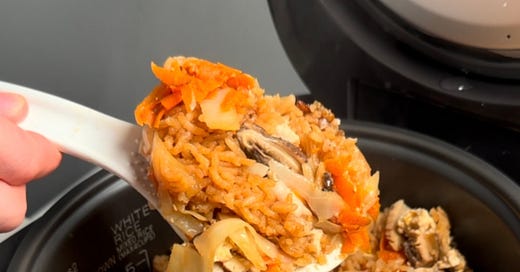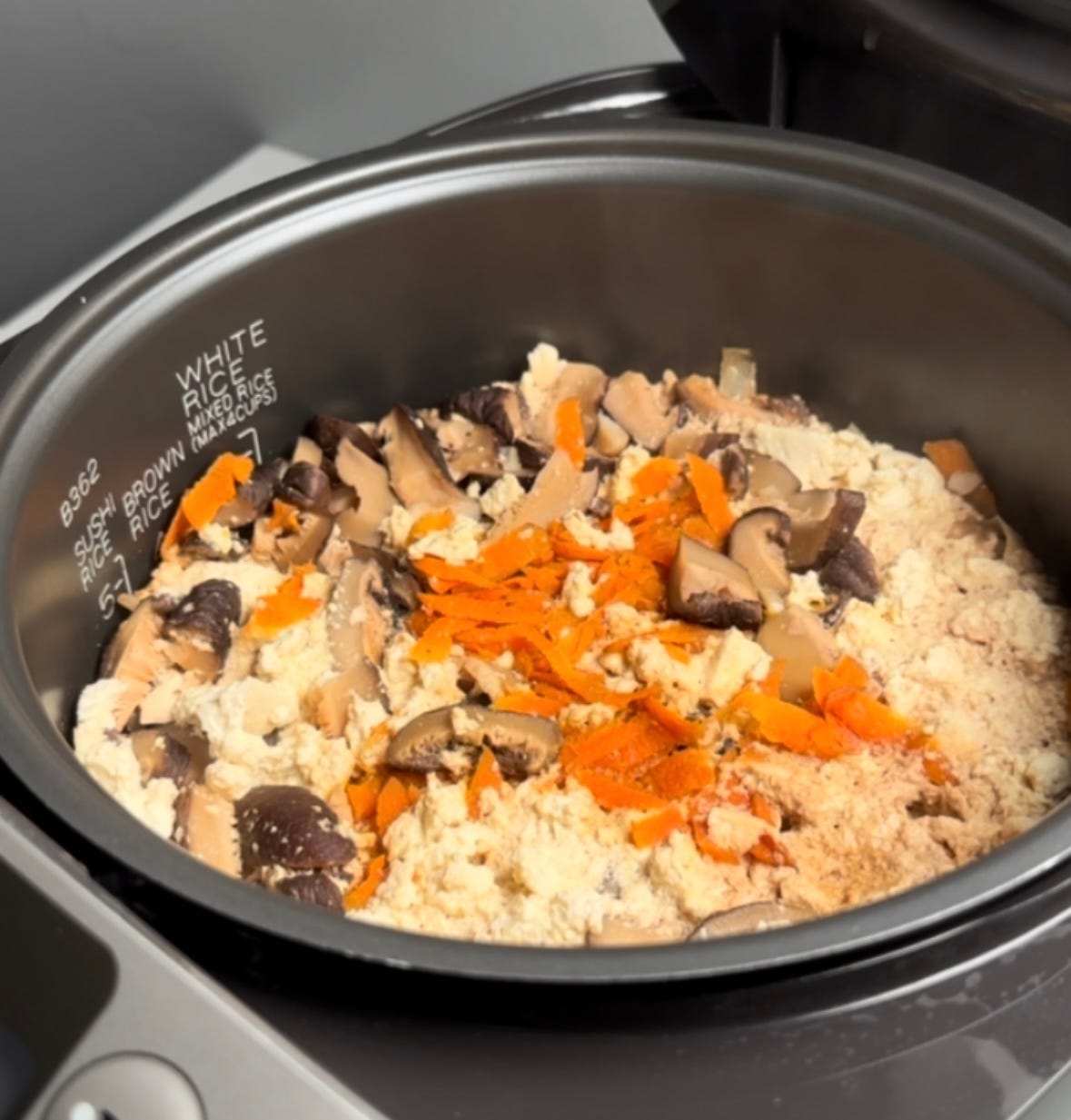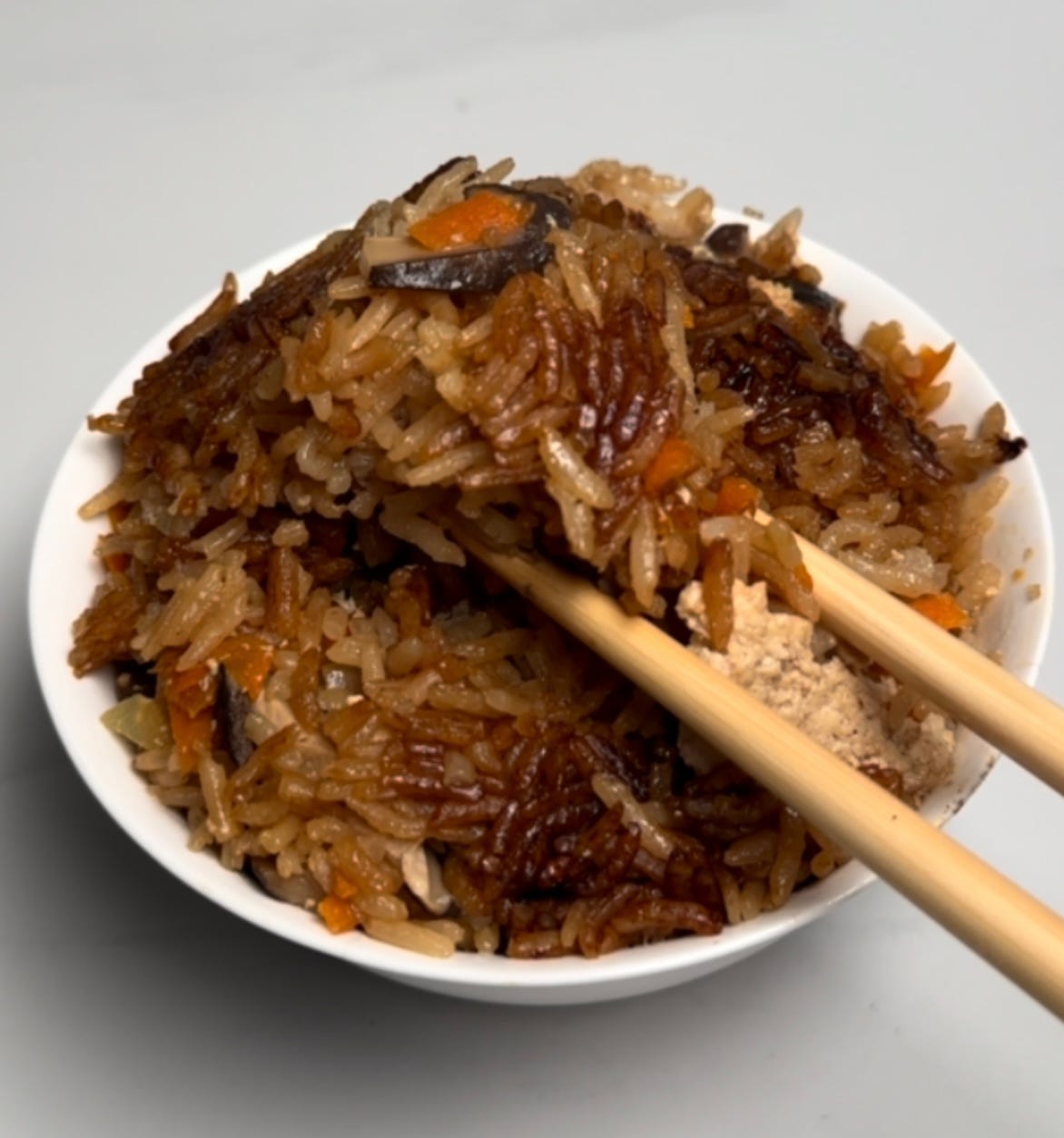I’ve been posting vegan recipes and tips on social media for nearly 3 years now but have barely monetized, beyond a few brand deals and affiliate income. This newsletter is one way I monetize via paid subscribers (thank you so much!!) but I’m thinking of other ways to make a bit of income from what I share online. I’m thinking about making a recipe ebook but am curious if there would be (literal) buy in 🤔
Anyways enough about me, let’s get to the recipe.
I love spring rolls, but I don’t love making them:
too much chopping / slicing
rolling them into the wrapper is time consuming
I’m not that into deep frying or even shallow frying at home - I’d rather leave it to restaurants who have a better set up than me
If you feel the same way: try making spring roll rice cooker rice!
Same ingredients as spring rolls, minus the spring roll wrapper and the frying, plus some rice.
You’ll still have to chop and slice the veggies, but at least rice cookers are more forgiving so you can be a bit lazy and imprecise with it.
Rice Cooker Spring Roll Rice
Serves: 4-6
Prep time: 10 minutes
Cook time: 60 minutes (the entirety of which your rice cooker is doing the work)
Tools:
Ingredients
Dry
1 1/2 cups rice
3/4 cup shredded carrot
3/4 cup finely sliced cabbage
4 cloves of garlic, minced
8 dried or fresh shiitake mushrooms, sliced thinly (rehydrate before slicing if dried)
1/2 block of medium firm tofu, crumbled
Sauce
1 tbsp sesame oil
3 tbsp vegetarian oyster sauce
1/2 tsp sugar
1/2 tsp salt
1 tbsp dark soya sauce or 2 tbsp light soya sauce (remember you can always add more salt later)
dash of white pepper (sub black pepper)
Method
Add the washed rice to your rice cooker.
Add water: place your fingertip on top of the rice and add water until it reaches your first knuckle. Or, add water up to the line that matches the amount of rice you used.
Add the liquids for the sauce: sesame oil, vegetarian oyster sauce, sugar, salt, dark or light soya sauce (depending on what you’re using), and a dash of white pepper.
Add the dry ingredients: carrot, cabbage, garlic, mushrooms, and tofu, and arrange it on the top of the rice so that everything is submerged as much as possible, but make sure these dry ingredients are on top of the rice.
Cook! If you have a fancy rice cooker (I just bought myself one for my birthday!) then use the “mixed” setting. Otherwise use the regular setting - you might need to add extra water and recook at the end if that’s the case.
To eat this I like to add more soya sauce — you can always add more salt to the rice when cooking it, but you can’t take it away, so this is why I like to add it to taste when I go to eat it.
Link to printer version.
Does this work in every rice cooker? Yes! I use a Zojirushi, which has a specific “mixed” setting for recipes like this. If you’re using a single setting rice cooker — one that only has an “on” button — then make sure to add extra water as the corn and tofu take a bit of moisture away from the rice. Try adding about 1.25 times the amount you would use for when you make plain white rice. If it comes out too mushy, try adding less water. If it’s too hard, add more water. You might need to engage in some trial and error as it can be rice cooker dependent.
Can I make this on the stove? Yes! Add a bit of extra water, relative to what you would use for plain white rice, as the corn and tofu take a bit of moisture away from the rice. If it comes out too hard then you can always add a bit more water and cook the rice for longer.
Can I make this in an instant pot? Yes! Add a bit of extra water as the dry ingredients take a bit of moisture away from the rice. 1.1 to 1.25 times the amount you would use for plain white rice should work.
Shaoxing cooking wine: You can omit this, or use sake, or white wine as a 1:1 replacement. You could also use 1/2 tbsp white vinegar or apple cider vinegar to replace the 1 tbsp of Shaoxing cooking wine that the recipe calls for.
White rice: You can use brown rice if you like, but keep in mind that brown rice requires more water than white rice.
Soya sauce:
If you’d prefer to, you can omit the soya sauce and use salt. So you would then use 1 tbsp + 1 tsp of salt for the recipe.
You could use miso paste as a soya sauce substitute in a 1:1 fashion.
Sesame oil: Feel free to omit, but it does add a nice flavour.
White pepper: White pepper is a common ingredient in Chinese cooking, and gives dishes that authentic flavour. But feel free to substitute black pepper!
Vegetarian oyster sauce: Feel free to omit, but highly recommended to include.
Vegetables: Carrot, cabbage, mushroom, and garlic are just one variation of spring roll fillings. Some other vegetables/herbs you can consider including or swapping in:
Green onion
White onion
Cilantro
Red pepper
Bean sprouts
Celery
Shredded carrot: Feel free to chop it finely instead of shredding.









